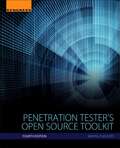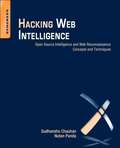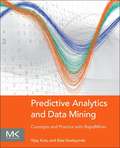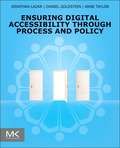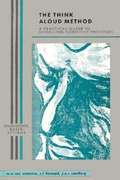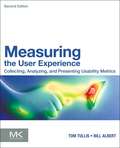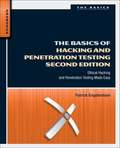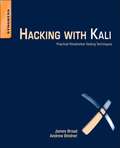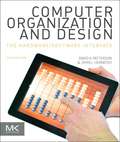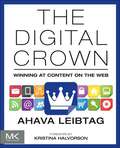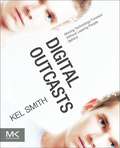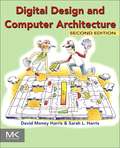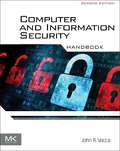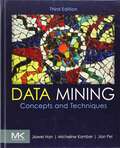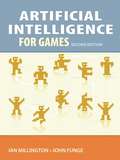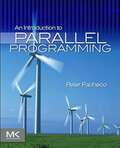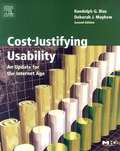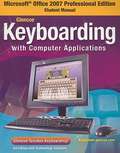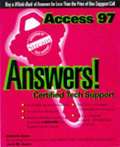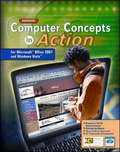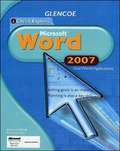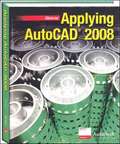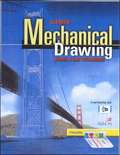- Table View
- List View
Penetration Tester's Open Source Toolkit
by Jeremy Faircloth<p>Continuing a tradition of excellent training on open source tools, Penetration Tester’s Open Source Toolkit, Fourth Edition is a great reference to the open source tools available today and teaches you how to use them by demonstrating them in real-world examples. This book expands upon existing documentation so that a professional can get the most accurate and in-depth test results possible. Real-life scenarios are a major focus so that the reader knows which tool to use and how to use it for a variety of situations. This updated edition covers the latest technologies and attack vectors, including industry specific case studies and complete laboratory setup. <p>Great commercial penetration testing tools can be very expensive and sometimes hard to use or of questionable accuracy. This book helps solve both of these problems. The open source, no-cost penetration testing tools presented work as well or better than commercial tools and can be modified by the user for each situation if needed. Many tools, even ones that cost thousands of dollars, do not come with any type of instruction on how and in which situations the penetration tester can best use them. Penetration Tester's Open Source Toolkil, Fourth Edition bridges this gap providing the critical information that you need.</p>
Hacking Web Intelligence: Open Source Intelligence and Web Reconnaissance Concepts and Techniques
by Sudhanshu Chauhan Nutan Kumar PandaOpen source intelligence (OSINT) and web reconnaissance are rich topics for infosec professionals looking for the best ways to sift through the abundance of information widely available online. In many cases, the first stage of any security assessment-that is, reconnaissance-is not given enough attention by security professionals, hackers, and penetration testers. Often, the information openly present is as critical as the confidential data. Hacking Web Intelligence shows you how to dig into the Web and uncover the information many don't even know exists. The book takes a holistic approach that is not only about using tools to find information online but also how to link all the information and transform it into presentable and actionable intelligence. You will also learn how to secure your information online to prevent it being discovered by these reconnaissance methods. Hacking Web Intelligence is an in-depth technical reference covering the methods and techniques you need to unearth open source information from the Internet and utilize it for the purpose of targeted attack during a security assessment. This book will introduce you to many new and leading-edge reconnaissance, information gathering, and open source intelligence methods and techniques, including metadata extraction tools, advanced search engines, advanced browsers, power searching methods, online anonymity tools such as TOR and i2p, OSINT tools such as Maltego, Shodan, Creepy, SearchDiggity, Recon-ng, Social Network Analysis (SNA), Darkweb/Deepweb, data visualization, and much more. Provides a holistic approach to OSINT and Web recon, showing you how to fit all the data together into actionable intelligence Focuses on hands-on tools such as TOR, i2p, Maltego, Shodan, Creepy, SearchDiggity, Recon-ng, FOCA, EXIF, Metagoofil, MAT, and many more Covers key technical topics such as metadata searching, advanced browsers and power searching, online anonymity, Darkweb / Deepweb, Social Network Analysis (SNA), and how to manage, analyze, and visualize the data you gather Includes hands-on technical examples and case studies, as well as a Python chapter that shows you how to create your own information-gathering tools and modify existing APIs
Predictive Analytics And Data Mining: Concepts And Practice With Rapidminer
by Vijay Kotu Bala DeshpandePut Predictive Analytics into Action Learn the basics of Predictive Analysis and Data Mining through an easy to understand conceptual framework and immediately practice the concepts learned using the open source RapidMiner tool. Whether you are brand new to Data Mining or working on your tenth project, this book will show you how to analyze data, uncover hidden patterns and relationships to aid important decisions and predictions. Data Mining has become an essential tool for any enterprise that collects, stores and processes data as part of its operations. This book is ideal for business users, data analysts, business analysts, business intelligence and data warehousing professionals and for anyone who wants to learn Data Mining. You'll be able to: 1. Gain the necessary knowledge of different data mining techniques, so that you can select the right technique for a given data problem and create a general purpose analytics process. 2. Get up and running fast with more than two dozen commonly used powerful algorithms for predictive analytics using practical use cases. 3. Implement a simple step-by-step process for predicting an outcome or discovering hidden relationships from the data using RapidMiner, an open source GUI based data mining tool Predictive analytics and Data Mining techniques covered: Exploratory Data Analysis, Visualization, Decision trees, Rule induction, k-Nearest Neighbors, Na ve Bayesian, Artificial Neural Networks, Support Vector machines, Ensemble models, Bagging, Boosting, Random Forests, Linear regression, Logistic regression, Association analysis using Apriori and FP Growth, K-Means clustering, Density based clustering, Self Organizing Maps, Text Mining, Time series forecasting, Anomaly detection and Feature selection. Implementation files can be downloaded from the book companion site at www.LearnPredictiveAnalytics.com Demystifies data mining concepts with easy to understand language Shows how to get up and running fast with 20 commonly used powerful techniques for predictive analysis Explains the process of using open source RapidMiner tools Discusses a simple 5 step process for implementing algorithms that can be used for performing predictive analytics Includes practical use cases and examples
Ensuring Digital Accessibility through Process and Policy
by Jonathan Lazar Daniel Goldstein Anne TaylorThis book provides readers with a resource to digital accessibility from both a technical and policy perspective.
The Think Aloud Method: A practical guide to modelling cognitive processes
by "Maarten W. van Someren Yvonne F. Barnard Jacobijn A. C. Sandberg "This book presents a detailed description of the Think Aloud Method, which was developed to facilitate knowledge acquisition and problem-solving by asking the participant to think aloud while solving a problem. The Think Aloud Method is based on the premise that people are often able to verbalize their thoughts as they solve a problem, and their resulting behavior can be analyzed to answer questions about problem solving behavior. This method is useful for psychological research on problem solving behavior, as well as for knowledge acquisition in the context of building expert computer programs. In many cases the Think Aloud Method is an invaluable source of information for psychologists and knowledge engineers.
Measuring the User Experience: Collecting, Analyzing, and Presenting Usability Metrics (Second Edition)
by William Albert Thomas TullisMeasuring the User Experience was the first book that focused on how to quantify the user experience. Now in the second edition, the authors include new material on how recent technologies have made it easier and more effective to collect a broader range of data about the user experience. As more UX and web professionals need to justify their design decisions with solid, reliable data, Measuring the User Experience provides the quantitative analysis training that these professionals need. The second edition presents new metrics such as emotional engagement, personas, keystroke analysis, and net promoter score. It also examines how new technologies coming from neuro-marketing and online market research can refine user experience measurement, helping usability and user experience practitioners make business cases to stakeholders. The book also contains new research and updated examples, including tips on writing online survey questions, six new case studies, and examples using the most recent version of Excel. Learn which metrics to select for every case, including behavioral, physiological, emotional, aesthetic, gestural, verbal, and physical, as well as more specialized metrics such as eye-tracking and clickstream data. Find a vendor-neutral examination of how to measure the user experience with web sites, digital products, and virtually any other type of product or system. Discover in-depth global case studies showing how organizations have successfully used metrics and the information they revealed. Companion site, www. measuringux. com, includes articles, tools, spreadsheets, presentations, and other resources to help you effectively measure the user experience
The Basics of Hacking and Penetration Testing: Ethical Hacking and Penetration Testing Made Easy
by David Kennedy Patrick EngebretsonThe Basics of Hacking and Penetration Testing serves as an introduction to the steps required to complete a penetration test or perform an ethical hack. You learn how to properly utilize and interpret the results of modern day hacking tools; which are required to complete a penetration test. Tool coverage will include, Backtrack Linux, Google, Whois, Nmap, Nessus, Metasploit, Netcat, Netbus, and more. A simple and clean explanation of how to utilize these tools will allow you to gain a solid understanding of each of the four phases and prepare them to take on more in-depth texts and topics. This book includes the use of a single example (pen test target) all the way through the book which allows you to clearly see how the tools and phases relate. Each chapter contains hands-on examples and exercises that are designed to teach you how to interpret the results and utilize those results in later phases. Written by an author who works in the field as a Penetration Tester and who teaches Offensive Security, Penetration Testing, and Ethical Hacking, and Exploitation classes at Dakota State University. Utilizes the Kali Linux distribution and focuses on the seminal tools required to complete a penetration test.
Hacking with Kali: Practical Penetration Testing Techniques
by James Broad Andrew BindnerHacking with Kali introduces you the most current distribution of the de facto standard tool for Linux pen testing. Starting with use of the Kali live CD and progressing through installation on hard drives, thumb drives and SD cards, author James Broad walks you through creating a custom version of the Kali live distribution. You'll learn how to configure networking components, storage devices and system services such as DHCP and web services. Once you're familiar with the basic components of the software, you'll learn how to use Kali through the phases of the penetration testing lifecycle; one major tool from each phase is explained. The book culminates with a chapter on reporting that will provide examples of documents used prior to, during and after the pen test. This guide will benefit information security professionals of all levels, hackers, systems administrators, network administrators, and beginning and intermediate professional pen testers, as well as students majoring in information security. Provides detailed explanations of the complete penetration testing lifecycle Complete linkage of the Kali information, resources and distribution downloads Hands-on exercises reinforce topics
Computer Organization and Design: The Hardware/Software Interface (Fifth Edition)
by David A. Patterson John L. HennessyComputer Organization and Design, Fifth Edition, is the latest update to the classic introduction to computer organization. The text now contains new examples and material highlighting the emergence of mobile computing and the cloud. It explores this generational change with updated content featuring tablet computers, cloud infrastructure, and the ARM (mobile computing devices) and x86 (cloud computing) architectures. The book uses a MIPS processor core to present the fundamentals of hardware technologies, assembly language, computer arithmetic, pipelining, memory hierarchies and I/O. Because an understanding of modern hardware is essential to achieving good performance and energy efficiency, this edition adds a new concrete example, Going Faster, used throughout the text to demonstrate extremely effective optimization techniques. There is also a new discussion of the Eight Great Ideas of computer architecture. Parallelism is examined in depth with examples and content highlighting parallel hardware and software topics. The book features the Intel Core i7, ARM Cortex-A8 and NVIDIA Fermi GPU as real-world examples, along with a full set of updated and improved exercises. This new edition is an ideal resource for professional digital system designers, programmers, application developers, and system software developers. It will also be of interest to undergraduate students in Computer Science, Computer Engineering and Electrical Engineering courses in Computer Organization, Computer Design, ranging from Sophomore required courses to Senior Electives.
The Digital Crown: Winning at Content on the Web
by Ahava LeibtagThe Digital Crown walks you through the essentials of crafting great content: the fundamentals of branding, messaging, business goal alignment, and creating portable, mobile content that is future-ready. Systems create freedom, and within this book you’ll learn the seven critical rules to align your internal and external content processes, including putting your audience first, involving stakeholders early and often, and creating multidisciplinary content teams.
Digital Outcasts: Moving Technology Forward Without Leaving People Behind
by Kel SmithThe blind person who tries to make an online purchase. The young girl who cannot speak due to a cognitive disability. The man confined to his home due to permanent injury. The single mother with a long-term illness who struggles to feed her family. With one in seven people worldwide currently living with a disability, the term "outcast" covers numerous scenarios. Digital outcasts rely on technology for everyday services that many people take for granted. However, poorly designed products risk alienating this important (and growing) population. Through a "grass roots" approach to innovation, digital outcasts are gradually taking action to transform their lives and communities. This emerging trend provides exciting learning opportunities for all of us. Citing real-world case studies from healthcare to social science, this book examines the emerging legal and cultural impact of inclusive design. Gain a better understanding of how people with disabilities use technology Discover pitfalls and approaches to help you stay current in your UX practices Anticipate a future in which ambient benefit can be achieved for people of all abilities and backgrounds.
Digital Design and Computer Architecture
by David Harris Sarah HarrisDigital Design and Computer Architecture, Second Edition, takes a unique and modern approach to digital design, introducing the reader to the fundamentals of digital logic and then showing step by step how to build a MIPS microprocessor in both Verilog and VHDL. This new edition combines an engaging and humorous writing style with an updated and hands-on approach to digital design. It presents new content on I/O systems in the context of general purpose processors found in a PC as well as microcontrollers found almost everywhere. <p><p> Beginning with digital logic gates and progressing to the design of combinational and sequential circuits, the book uses these fundamental building blocks as the basis for the design of an actual MIPS processor. It provides practical examples of how to interface with peripherals using RS232, SPI, motor control, interrupts, wireless, and analog-to-digital conversion. SystemVerilog and VHDL are integrated throughout the text in examples illustrating the methods and techniques for CAD-based circuit design. There are also additional exercises and new examples of parallel and advanced architectures, practical I/O applications, embedded systems, and heterogeneous computing, plus a new appendix on C programming to strengthen the connection between programming and processor architecture. <p> This new edition will appeal to professional computer engineers and to students taking a course that combines digital logic and computer architecture.
Computer and Information Security Handbook
by John R. VaccaThe second edition of this comprehensive handbook of computer and information security provides the most complete view of computer security and privacy available. It offers in-depth coverage of security theory, technology, and practice as they relate to established technologies as well as recent advances. It explores practical solutions to many security issues. Individual chapters are authored by leading experts in the field and address the immediate and long-term challenges in the authors' respective areas of expertise. The book is organized into 10 parts comprised of 70 contributed chapters by leading experts in the areas of networking and systems security, information management, cyber warfare and security, encryption technology, privacy, data storage, physical security, and a host of advanced security topics.
Data Mining: Concepts And Techniques (Morgan Kaufmann Series In Data Management System)
by Jiawei Han Micheline Kamber Jian PeiData Mining: Concepts and Techniques (The Morgan Kaufmann Series in Data Management Systems) 3rd Edition
Artificial Intelligence for Games
by Ian Millington John FungeCreating robust artificial intelligence is one of the greatest challenges for game developers, yet the commercial success of a game is often dependent upon the quality of the AI. In this book, Ian Millington brings extensive professional experience to the problem of improving the quality of AI in games. He describes numerous examples from real games and explores the underlying ideas through detailed case studies. He goes further to introduce many techniques little used by developers today. The book's associated web site contains a library of C++ source code and demonstration programs, and a complete commercial source code library of AI algorithms and techniques. "Artificial Intelligence for Games - 2nd edition" will be highly useful to academics teaching courses on game AI, in that it includes exercises with each chapter. It will also include new and expanded coverage of the following: AI-oriented gameplay; Behavior driven AI; Casual games (puzzle games).
An Introduction to Parallel Programming
by Peter PachecoAn Introduction to Parallel Programming by Pacheco, Peter
Cost-Justifying Usability: An Update for an Internet Age
by Randolph G. Bias Deborah J. MayhewYou just know that an improvement of the user interface will reap rewards, but how do you justify the expense and the labor and the time-guarantee a robust ROI!-ahead of time? How do you decide how much of an investment should be funded? And what is the best way to sell usability to others? In this completely revised and new edition, Randolph G. Bias (University of Texas at Austin, with 25 years' experience as a usability practitioner and manager) and Deborah J. Mayhew (internationally recognized usability consultant and author of two other seminal books including The Usability Engineering Lifecycle) tackle these and many other problems. It has been updated to cover cost-justifying usability for Web sites and intranets, for the complex applications we have today, and for a host of products-offering techniques, examples, and cases that are unavailable elsewhere. No matter what type of product you build, whether or not you are a cost-benefit expert or a born salesperson, this book has the tools that will enable you to cost-justify the appropriate usability investment. 66
The Emperor's New Mind
by Roger PenroseWinner of the 1990 Science Book Prize arguing AGAINST artificial intelligence, and exploring the mystery of the mind and consciousness, Roger Penrose takes the reader on the most engaging and creative tour of modern physics, cosmology, mathematics and philosophy that has ever been written.
Glencoe Keyboarding with Computer Applications
by McGraw-HillMicrosoft Word 2007 is a powerful word processing program. Using this program, you can create documents that contain tables, artwork, and decorative fonts.
Access 97 Answers! Certified Tech Support
by Edward Jones Jarrel JoneskAnswers to the 1,000 most commonly asked questions about Microsoft Access. Most answers are provided in step-by-step text format with not a lot of diagrams and figures.
Computer Concepts in Action
by Stephen E. HaagGlencoe'sComputer Concepts in Actionrevised edition is designed for Microsoft Office 2007 and Windows Vista. It is written specifically to meet the needs of secondary students and teachers, and meets IC3 Standards. This highly visual text teaches essential computer concepts and skills through hands-on activities and projects. Concepts such as ethics, careers, hardware and software applications, the Internet, and e-commerce, are taught using high-interest topics and real-world scenarios that are designed to engage students.
Computer Concepts in Action
by Stephen E. HaagGlencoe'sComputer Concepts in Actionrevised edition is designed for Microsoft Office 2007 and Windows Vista. It is written specifically to meet the needs of secondary students and teachers, and meets IC3 Standards. This highly visual text teaches essential computer concepts and skills through hands-on activities and projects. Concepts such as ethics, careers, hardware and software applications, the Internet, and e-commerce, are taught using high-interest topics and real-world scenarios that are designed to engage students.
Microsoft Word 2007, Real World Applications
by C. Jacqueline Schultz Linda WooldridgeGlencoe's Microsoft Word 2007 is an engaging top-bound text which provides students with applications that apply to everyday life! Written specifically for high school students, this rigorous express series provides extensive step-by-step exercises and projects that prepare students for MCAS certification. It is age-level and interest-level appropriate. The student edition includes integration of basic language arts and mathematics skills.
Applying AutoCad 2008
by Terry T. WohlersApplying AutoCAD 2008introduces new features and enhancements to existing capabilities. What's New in 2008? * A new default workspace called 2DDrafting & Annotationhas been added. * The new 2D Drafting and Annotation workspace employs a new Dashboard containing panels and toolbars for drawing and dimensioning in two dimensions, while new panels and features improve the Dashboard for the 3D Modeling workspace. * New dimensioning capabilities are introduced, including a new Multileader tool and easy alignment and spacing control of dimension lines. * New commands and features to control drawing annotations are added to simplify and improve Multiline text, text styles, tables, and the creation of bill of materials.
Glencoe Mechanical Drawing: Board and CAD Techniques
by Glencoe McGraw-Hill StaffProject-based learning prepares students for professional certification with Glencoe Mechanical Drawing: Board and CAD Techniques! Endorsed by the American Design Drafting Association (ADDA), this text includes Prep for ADDA activities. Step-by-step applications, design problems, and drafting problems prepare students for professional excellence and certification. Project-based learning is supported with unit-based projects that integrate technical math and culminate in Build Your Portfolio activities. Help your students get ready for competitive events like the TSA and SkillsUSA with prep activities embedded throughout the content and end-of-chapter assessments. Rigorous academic content is supported, with a special emphasis on math, geometry, and science, with STEM activities. Point-of-use correlations ease possible academic credit application. Extra activities in the Student Edition and workbook help you meet Perkins mandates. The appendix features Math (including algebra and geometry), abbreviations and symbols, pipe symbols, and reference tables (ASME, ANSI, ISO).
